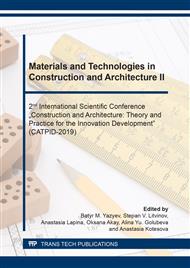p.515
p.521
p.529
p.535
p.542
p.551
p.556
p.564
p.570
Experimental Studies of the Parameters of the Contact Problem in the Design of Plastic Tube Concrete Structures
Abstract:
The article presents numerical studies of the stress-strain state of the centrally compressed short plastic-concrete-tubal vertical constructions (PCT). The authors experimentally obtained and analyzed the effect of friction on the boundary between the layers of the concrete core and the plastic tube on the stress-strain state of the PCT vertical constructions. The need to carry out these studies is associated with a deficiency of theoretical and numerical studies of this phenomenon, including for the traditional pipe concrete in a steel tube. In this regard, mathematical modeling and the creation of engineering methods for calculating the PCT based on the study of the factual joint operation of the concrete core and the cylindrical plastic shell has significant scientific potential. The calculations and experimental analysis demonstrated the validity with engineering accuracy of using the mathematical model of a short PCT column for engineering calculations and structural analysis. It has been established that the use of an analytical model makes it possible to investigate the influence of the variation of the physical and mechanical characteristics properties of the materials of the core and tube of the PCT on the parameters of the stress-strain state design and to carry out a rational design of the PCT elements in the structures of civil and industrial buildings with reference to the materials actually used widely represented in the market.
Info:
Periodical:
Pages:
542-550
Citation:
Online since:
December 2019
Authors:
Price:
Сopyright:
© 2020 Trans Tech Publications Ltd. All Rights Reserved
Share:
Citation:


